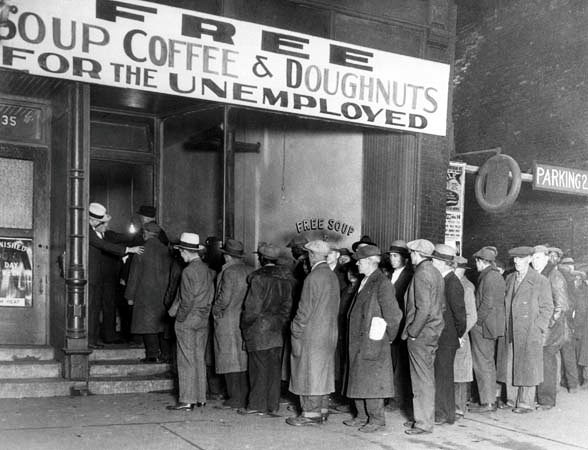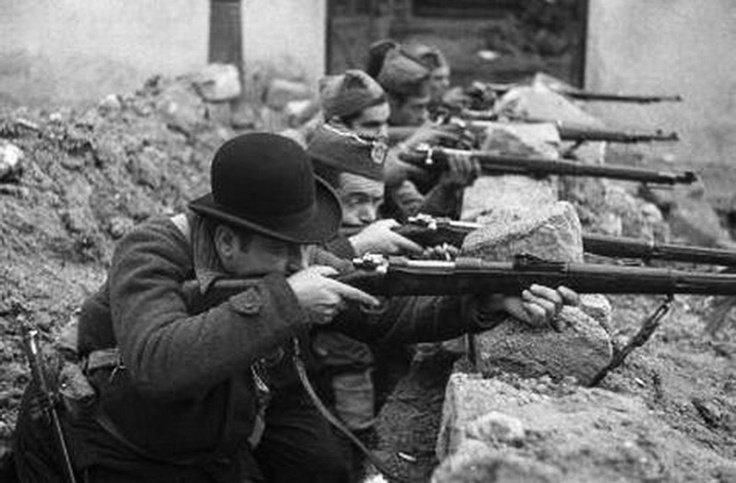1. The road to the 1936 United States presidential elections.
1. The road to the 1936 United States presidential elections.
The history of the Second American Civil War and its aftermath, along with the United States' role in the Second World War, is, considered by historians to have been one of the turning points of the 20th century, even if its legacy is studlled muddled by the controversy and the still ongoing debate. This conflict is often considered as a dress rehearsal for the Second World War, where both the United States itself and the Reichspakt, the Entente, and the Internationale tested out new doctrines, weaponry and technologies for the great clash that would engulf the world in the 1940s. Considered then as the last "romantic" war, it was seen, then, as the three-sided battle for Democracy, for Syndicalism’s global revolution, or for the order and stability craved by authoritarians of the far-right. It would have a lasting impact on the culture of the United States, as the shadow of the conflict still lingers in the music, literature, and the American psyche, as it can bee seen in countless films, shows, books, and games.
Hoover knew that, unless unemployment was curbed and the conditions and salaries of the workers raised, democracy in the United States may collapse. However, his reforms were an unmitigated disaster. He managed to lower national interest rates and tariffs by nearly half, sparking a surge in investment. However, the raise of taxes to fight the looming budget deficit hit the lower and middle classes hard. With unemployment hovering at approximately 28%, domestic consumption nose-dived and stock prices plummeted as countless businesses quickly became bankrupt, with banks trapped with the insolvent loans. Thus, as the situation deteriorated, new political forces began to appear. In the Red Belt of the Midwest and the Great Lakes, Bolshevik politicians openly demanded radical changes to the nation, while the Deep South and rural Great Plains brought ultra-nationalist authoritarians and populist demagogues determined to rebuild America as they saw fit.
By the beginning of 1936, it was clear that the November presidential election would be like no other. The fruits of the recession that had darkened the roaring Twenties and then plagued the United States in the Thirties were ready to be reaped. When three Senators and twelve House Representatives arrived in Washington after the 1934 midterm elections claiming to be Bolsheviks - not Socialists, Bolsheviks -, the country held its breath. Faced with sharp unemployment, low wages, and corporate greed, the reaction of American voters began to take a turn to the left. Inspired by the Syndicalist victories in France and southern Italy, the American Socialist and Communist Parties negotiated a possible merge of the two parties, but the constant bleeding of Socialists that left the party to become Communists ended the talks. Led by John 'Jack' Reed, a Harvard graduate and one of the few American witnesses to the failed October Revolution and bolstered by the abuses of America's capitalist system, the Syndicalist Party of America (SPA) threatened to end the dominion of the Democratic and Republican parties over American politics since the First American Civil War, but his radicalism was outright rejected by La Follete's Progressive Party and by the American Federation of Labor (AFL), which caused a split in the trade union as John L. Lewis, Sidney Hillman, David Dubinsky, Charles Howard, Thomas McMahon Maxx Zaritsky broke away and created the Congress of Industrial Organizations (CIO), which then endorsed Reed.
As a reaction against Reed emerged Governor Huey Long of Louisiana. Technically a Democrat, Long won popularity throughout the South for his fiery condemnations of big business and upper-class 'parasites.' Considered a demagogue by his opponents, Long was seen by many as the defender of workers, particularly farmers and small-townspeople, against the yoke of big business corporations and government corruption. Thus, on September 8, 1935, several Democratic Congressmen united under Long's leadership and formed the National Populist Party. Both the Communists and Nationals gained substantial ground in the polls as 1936 began, having the advantage of fresh candidates and willing audiences, anxious to be offered a solution to their troubles. The last sixteen years had discredited the two major political parties, and the rise of the two new parties was read by many that if the United States was ever going to emerge from the economic quagmire, it would require radical, even revolutionary change from its past.
This only made worse the situation of President Hoover, who was in serious danger of losing the Republican nomination, while many wondered who would picked out as the Democratic candidate in June.

Huey Long and John Reed,
two men determined to shape the fate of the United States
The history of the Second American Civil War and its aftermath, along with the United States' role in the Second World War, is, considered by historians to have been one of the turning points of the 20th century, even if its legacy is studlled muddled by the controversy and the still ongoing debate. This conflict is often considered as a dress rehearsal for the Second World War, where both the United States itself and the Reichspakt, the Entente, and the Internationale tested out new doctrines, weaponry and technologies for the great clash that would engulf the world in the 1940s. Considered then as the last "romantic" war, it was seen, then, as the three-sided battle for Democracy, for Syndicalism’s global revolution, or for the order and stability craved by authoritarians of the far-right. It would have a lasting impact on the culture of the United States, as the shadow of the conflict still lingers in the music, literature, and the American psyche, as it can bee seen in countless films, shows, books, and games.
Hoover knew that, unless unemployment was curbed and the conditions and salaries of the workers raised, democracy in the United States may collapse. However, his reforms were an unmitigated disaster. He managed to lower national interest rates and tariffs by nearly half, sparking a surge in investment. However, the raise of taxes to fight the looming budget deficit hit the lower and middle classes hard. With unemployment hovering at approximately 28%, domestic consumption nose-dived and stock prices plummeted as countless businesses quickly became bankrupt, with banks trapped with the insolvent loans. Thus, as the situation deteriorated, new political forces began to appear. In the Red Belt of the Midwest and the Great Lakes, Bolshevik politicians openly demanded radical changes to the nation, while the Deep South and rural Great Plains brought ultra-nationalist authoritarians and populist demagogues determined to rebuild America as they saw fit.
By the beginning of 1936, it was clear that the November presidential election would be like no other. The fruits of the recession that had darkened the roaring Twenties and then plagued the United States in the Thirties were ready to be reaped. When three Senators and twelve House Representatives arrived in Washington after the 1934 midterm elections claiming to be Bolsheviks - not Socialists, Bolsheviks -, the country held its breath. Faced with sharp unemployment, low wages, and corporate greed, the reaction of American voters began to take a turn to the left. Inspired by the Syndicalist victories in France and southern Italy, the American Socialist and Communist Parties negotiated a possible merge of the two parties, but the constant bleeding of Socialists that left the party to become Communists ended the talks. Led by John 'Jack' Reed, a Harvard graduate and one of the few American witnesses to the failed October Revolution and bolstered by the abuses of America's capitalist system, the Syndicalist Party of America (SPA) threatened to end the dominion of the Democratic and Republican parties over American politics since the First American Civil War, but his radicalism was outright rejected by La Follete's Progressive Party and by the American Federation of Labor (AFL), which caused a split in the trade union as John L. Lewis, Sidney Hillman, David Dubinsky, Charles Howard, Thomas McMahon Maxx Zaritsky broke away and created the Congress of Industrial Organizations (CIO), which then endorsed Reed.
As a reaction against Reed emerged Governor Huey Long of Louisiana. Technically a Democrat, Long won popularity throughout the South for his fiery condemnations of big business and upper-class 'parasites.' Considered a demagogue by his opponents, Long was seen by many as the defender of workers, particularly farmers and small-townspeople, against the yoke of big business corporations and government corruption. Thus, on September 8, 1935, several Democratic Congressmen united under Long's leadership and formed the National Populist Party. Both the Communists and Nationals gained substantial ground in the polls as 1936 began, having the advantage of fresh candidates and willing audiences, anxious to be offered a solution to their troubles. The last sixteen years had discredited the two major political parties, and the rise of the two new parties was read by many that if the United States was ever going to emerge from the economic quagmire, it would require radical, even revolutionary change from its past.
This only made worse the situation of President Hoover, who was in serious danger of losing the Republican nomination, while many wondered who would picked out as the Democratic candidate in June.
Huey Long and John Reed,
two men determined to shape the fate of the United States
Last edited:







